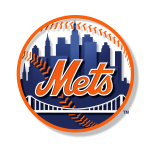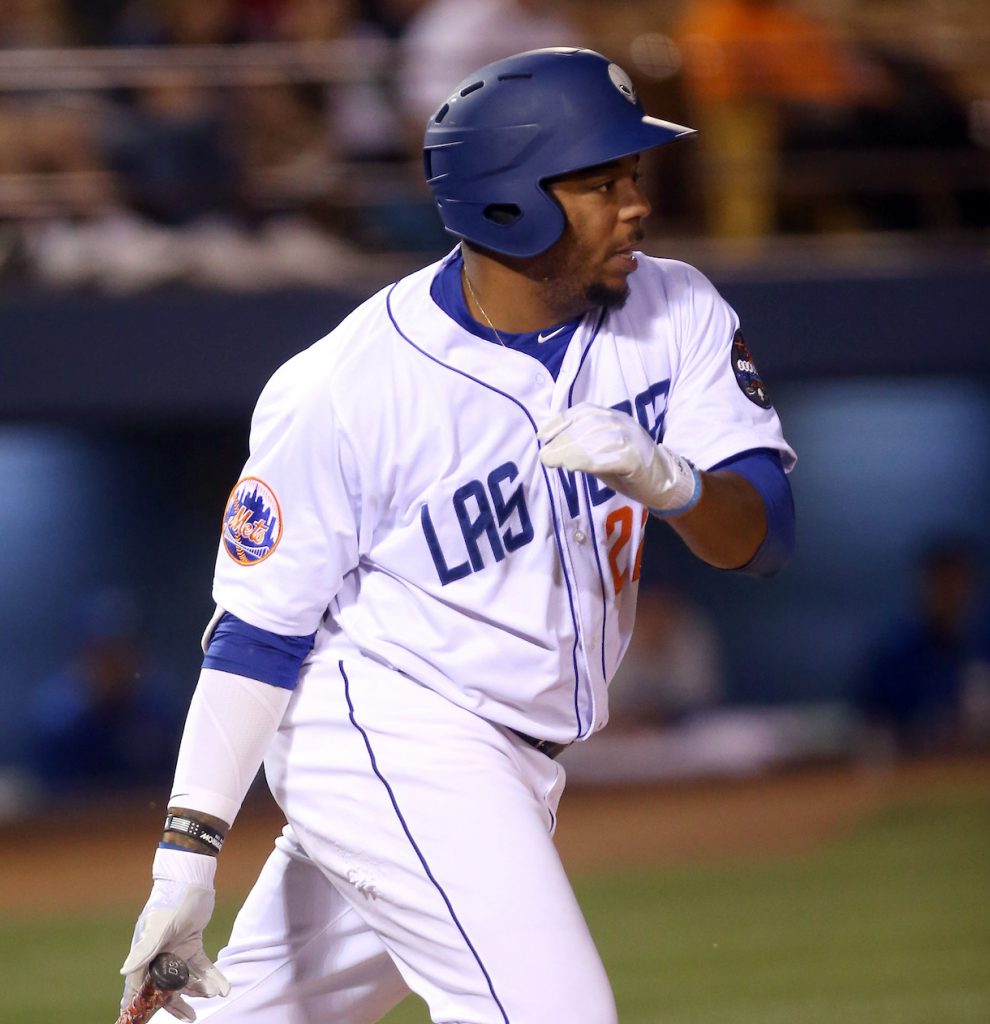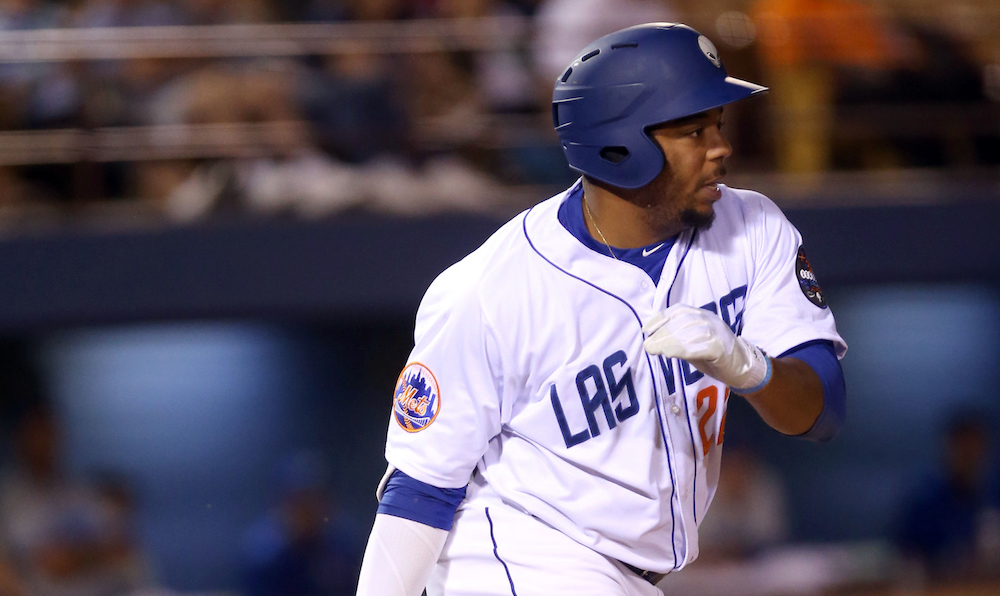Feature Photo: Dominic Smith, 1B, Mets
Editor’s Note: 2080 Baseball is publishing weekly profiles of former Perfect Game All-Americans as they progress through the professional ranks. The series will be published each Wednesday and run through the 2017 Perfect Game National Showcase, to be held June 16-21 in Fort Myers, FL. We’d also like to offer our special appreciation to David Rawnsley, vice president of player personnel for Perfect Game, and Patrick Ebert, PG’s managing editor and scout, for their contributions to the PG in the Pros series. – Mark Shreve
 Much of southern California is a hotbed of amateur baseball talent, but growing up in Gardena left Dominic Smith mostly obscured from major league scouts because his high school — Junipero Serra – has produced only a handful of draft picks, and none of whom have reached the major leagues. But despite this, Smith learned early to take advantage of his proximity to places like Orange County and San Diego where the eyes of big league ball clubs routinely scour for the best high school ballplayers, and where national showcase tournaments have sprouted, such as the Perfect Game All-American Classic (held at Petco Park) and the Area Code Games (held in Long Beach, CA). So it was that as a sophomore in high school, he started going to Perfect Game USA showcases in his area.
Much of southern California is a hotbed of amateur baseball talent, but growing up in Gardena left Dominic Smith mostly obscured from major league scouts because his high school — Junipero Serra – has produced only a handful of draft picks, and none of whom have reached the major leagues. But despite this, Smith learned early to take advantage of his proximity to places like Orange County and San Diego where the eyes of big league ball clubs routinely scour for the best high school ballplayers, and where national showcase tournaments have sprouted, such as the Perfect Game All-American Classic (held at Petco Park) and the Area Code Games (held in Long Beach, CA). So it was that as a sophomore in high school, he started going to Perfect Game USA showcases in his area.
Smith’s work in these amateur showcases – and a stellar senior season at Junipero Serra in which he hit .493 and slugged seven home runs – paid off. Smith’s name was called in the 2013 MLB First-Year Player Draft when he was selected by the Mets in the first round (#11 overall) in 2013, and he was signed to a $2.6 million bonus. But to reach that point, the first baseman had to get himself seen by the right people while playing in a high school league where many players see their talent hidden by the misfortune of geography. So for Smith, that meant pushing himself outside of his community, and into the showcase circuit to test his abilities against higher-level competition.
“I grew up in the inner city in LA, and there’s just not that much baseball exposure in that area. You get to the high school leagues there, and maybe one or two teams are good, and you see one, maybe two pitchers who might go D1.” Smith said in a recent interview.
Before he even arrived in high school, Smith started visiting the Major League Baseball Urban Youth Academy in nearby Compton to join travel teams. This gave him early exposure to talent that Smith would not otherwise have had the opportunity to play against. Then, as a sophomore in high school, Smith got involved in his first showcases with Perfect Game.
“This helped my career tremendously,” Smith said. “It put me on the national stage, where hundreds of scouts came out to watch kids play.”
It was at this time when Smith first began working with David Rawnsley, Perfect Game’s vice president of player personnel and a former scout for the Houston Astros. Rawnsley was quick to see the raw potential in Smith, even at just 15 years old.
“He had incredible barrel-to-ball skills in high school. He could hit to all fields and hit different types of pitches [as a 15-year-old].” Rawnsley said.
No hit tool is without need for improvement, however, and Smith’s in-game power – abundantly evident as an amateur and in the showcase setting – has yet to translate fully into the pros, though the overall hit tool has. Some might see as a cause for concern that in over 450 games in the minor leagues, Smith has just 29 home runs to his name to-date. He hit almost half of these (14) in 2016 while with Double-A Binghamton in the Eastern League.
That increase in home runs last season seems to suggest that his in-game power is coming around. Whether this fully develops or not, Smith is building on his success at the plate in other ways. In 2016, he increased his walk rate from the previous year, adding 15 extra free passes in just 28 more plate appearances. Even without the power in 2014 and 2015, Smith put up big-time numbers at the plate, and already this season he has added five more home runs to his career total, along with 11 other extra-base hits, in 166 plate appearances with Triple-A Las Vegas in the Pacific Coast League, where he is slashing an impressive .329/.386/.507 (through May 16). Quite simply, the dude can hit, in-game power or not.
Rawnsley was quick to downplay the in-game power concerns, though.

Dominic Smith, 1B, Mets playing for the Las Vegas 51s in the Pacific Coast League this year.
“The cliché in scouting is that power is the last tool to develop. With Dominic it is going to be that. He is not going to be a Casey Kotchman (1B, MLB, 2004-2013, multiple teams), James Loney (1B, MLB, 2006-2016, multiple teams) type of player. The power is there and it will develop as he gets older.” Rawnsley said.
The ballparks of the Mets’ minor league affiliates are not particularly home run friendly, either. Rawnsley pointed this out along with the fact that, with consistency, Smith has been playing well below the average age of players at each minor league level he’s played at, so he has spent his entire professional career ‘playing up’ to opponents with more experience than he has. Currently, Smith is nearly 4.75 years younger than the average age in the Pacific Coast League, and at Double-A Binghamton in 2016 he was 3.9 years younger than the league average. This is pertinent to his development because at 22 years old, he has spent his time learning the game playing against advanced level professionals, rather than toiling in the college ranks. Prior to reaching the Pacific Coast League this year, Smith has ranged from a year and a half to three and a half years younger than the average age of his competition. Perhaps because of this, the Mets have given him a full season of development at each step, and they’ve shown patience in avoiding any mid-season promotions.
“He’s not one of those guys who spent three years in college developing those skills. No doubt he can hit with power. The doubles are there. The high contact ratio is there. Power is going to be there.” Rawnsley said. Smith has hit 19 of his professional home runs in the past two seasons, and his HR/FB rate keeps climbing; it has doubled from 5 percent in 2015 to 10 percent this season.
Smith did intend fully on playing in college originally, with his sights set on the University of Southern California.
“I’m a big Trojan fan, and even though playing pro baseball was my ultimate goal, I still wanted to go there.” Smith said.
But when the Mets took Smith so early in the first round in June 2013, Smith had to reconsider his options.
“I got picked pretty high, but I asked for them to pay for college in my contract. I put off school to pursue my dream.” Smith said. “I told them that was what I wanted, or I was not going to sign.”
This was a savvy move on Smith’s part, given that even the most highly touted prospects can fall short of major league success (of the 330 first-rounders taken between 2000 and 2010, roughly 26 percent never reached the majors), and according to Rawnsley, insisting on negotiating this into his contract is a microcosm of the kind of person Smith is. He cites a similar examples of his personality where Smith drove a teammate of his who did not have his own means to travel to a Perfect Game showcase 50 miles away, just so this friend could get some much-needed visibility in front of scouts.
“Off the field, he’s just one of my favorite makeup players ever.” Rawnsley said.
So what does Smith make of these power concerns? Like Rawnsley, he knows that the power can come with time, but presently, he has different developmental goals at the plate.
“The biggest obstacle is consistently hitting the ball hard, which is tough to do at any level. I want to continuously work on my approach and control the strike zone. I can’t constantly chase bad pitches, I have to focus on my strike zone.” Smith said.
This season he’s striking out about 16 percent of the time, which is higher than he has previously posted in his professional career, but Smith has had a very productive year at the plate regardless. Through 166 plate appearances, he is hitting .329 and getting on base nearly 40 percent of the time, even with a walk rate that, so far, sits around 7.5 percent. So while Smith has been successful in the first month of this season, he is still using his time in the Pacific Coast League to focus on his plate discipline, and controlling the strike zone.
But when he does get the call from the big league club, Rawnsley suspects that he will be there to stay, though that might require New Yorkers to exercise some patience with his power numbers. That, as Rawnsley stated, will be the last tool to develop for Smith, as he has hit steadily throughout his tenure in the minors, and his defense at first base holds up as well. In fact, Rawnsley sees him as a potential gold-glove defender at the position.
“He has special hands and an instinctual understanding of the game.” Rawnsley said. “He does the things you want to see from a first baseman; he picks the ball, gets under pop-ups, and makes catches off of the bag.”
So while so many of the tools are close to major league ready at such a young age, Rawnsley does fear that at 6-feet tall and 250 pounds, Smith might need to shed some weight.
“I’m worried about his size at 250 pounds.” Rawnsley said. “He never had a very projectable body, so that might be too big.”
So far, of course, this has not proven to be a problem for Smith, and Rawnsley agrees that to this point, Smith has not been held back by it. Other than a stint on the disabled list in April 2015 while he was with High A Port St. Lucie in the Florida State League, Smith has had no trouble playing full seasons, and has essentially done so every year he has been in the Mets’ system.
“I have no doubt that he can go through a 162-game season and play hard every day.” Rawnsley said.
Smith talked about his own adjustments to a full season of professional baseball when he transitioned from rookie ball to Class A Savannah in the South Atlantic League in 2014, sharing with me that it taught him a great deal about the preparation it takes to be ready to produce every day, and that the first full season as a pro helped him grow and made him a better player.
The weight concern might be minor enough not to warrant significant attention. Whenever he does get to New York, though, Rawnsley is sure of one thing: Smith is going to be worth the wait.
“Be patient with Dominic Smith, and you’re going to have a very good first baseman. You’re not going to have to worry about that position for a very long time.” Rawnsley said.


